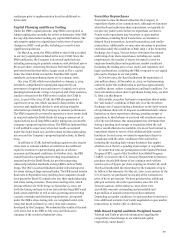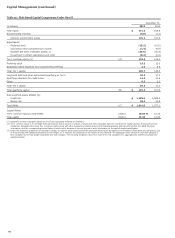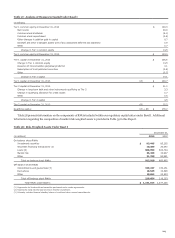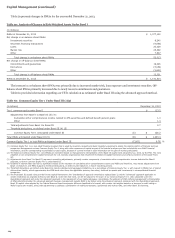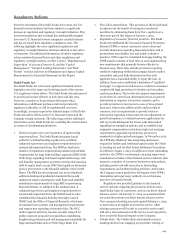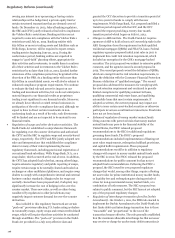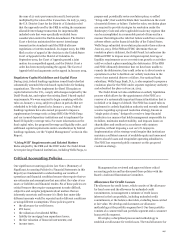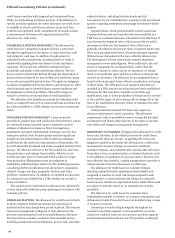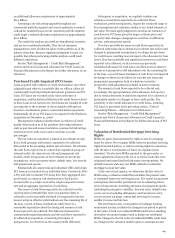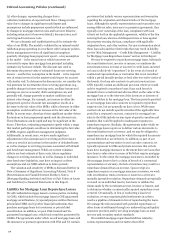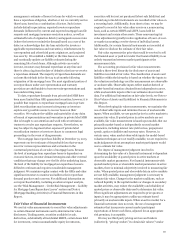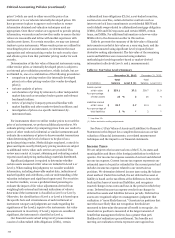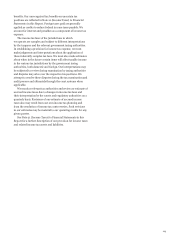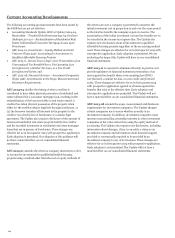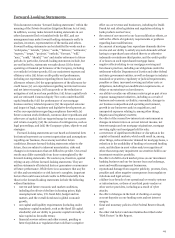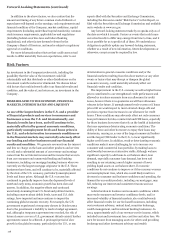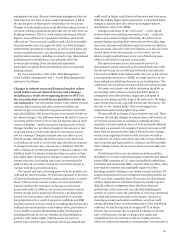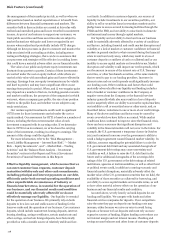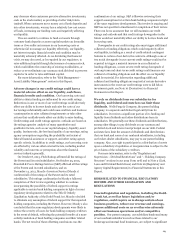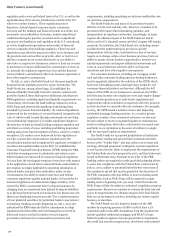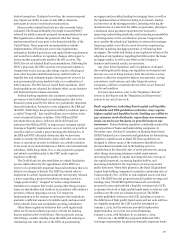Wells Fargo 2013 Annual Report Download - page 113
Download and view the complete annual report
Please find page 113 of the 2013 Wells Fargo annual report below. You can navigate through the pages in the report by either clicking on the pages listed below, or by using the keyword search tool below to find specific information within the annual report.management’s estimate of losses for loans for which we could
have a repurchase obligation, whether or not we currently service
those loans, based on a combination of factors. Such factors
include default expectations, expected investor repurchase
demands (influenced by current and expected mortgage loan file
requests and mortgage insurance rescission notices, as well as
estimated levels of origination defects) and appeals success rates
(where the investor rescinds the demand based on a cure of the
defect or acknowledges that the loan satisfies the investor’s
applicable representations and warranties), reimbursement by
correspondent and other third party originators, and projected
loss severity. We establish a liability at the time loans are sold
and continually update our liability estimate during the
remaining life of such loans. Although activity can vary by
investor, investors may demand repurchase at any time and
there is often a lag from the date of default to the time we receive
a repurchase demand. The majority of repurchase demands are
on loans that default in the first 24 to 36 months following
origination of the mortgage loan. The most significant portion of
our repurchases under our representation and warranty
provisions are attributable to borrower misrepresentations and
loan underwriting issues.
To date, repurchase demands from private label MBS have
been more limited than GSE-guaranteed securities; however, it is
possible that requests to repurchase mortgage loans in private
label securitizations may increase in frequency as investors
explore every possible avenue to recover losses on their
securities. We evaluate the validity and materiality of any claim
of breach of representations and warranties in private label MBS
that is brought to our attention and work with securitization
trustees to resolve any repurchase requests. Nevertheless, we
may be subject to legal and other expenses if private label
securitization trustees or investors choose to commence legal
proceedings in the event of disagreements.
The mortgage loan repurchase liability at December 31, 2013,
represents our best estimate of the probable loss that we may
incur for various representations and warranties in the
contractual provisions of our sales of mortgage loans. Because
the level of mortgage loan repurchase losses is dependent on
economic factors, investor demand strategies and other external
conditions that may change over the life of the underlying loans,
the level of the liability for mortgage loan repurchase losses is
difficult to estimate and requires considerable management
judgment. We maintain regular contact with the GSEs and other
significant investors to monitor and address their repurchase
demand practices and concerns. For additional information on
our repurchase liability, including an adverse impact analysis,
see the “Risk Management – Credit Risk Management – Liability
for Mortgage Loan Repurchase Losses” section and Note 9
(Mortgage Banking Activities) to Financial Statements in this
Report.
Fair Value of Financial Instruments
We use fair value measurements to record fair value adjustments
to certain financial instruments and to determine fair value
disclosures. Trading assets, securities available for sale,
derivatives, substantially all residential MHFS, certain loans held
for investment, certain nonmarketable equity investments,
securities sold but not yet purchased (short sale liabilities) and
certain long-term debt instruments are recorded at fair value on
a recurring basis. Additionally, from time to time, we may be
required to record at fair value other assets on a nonrecurring
basis, such as certain MHFS and LHFS, loans held for
investment and certain other assets. These nonrecurring fair
value adjustments typically involve application of lower-of-cost-
or-market accounting or write-downs of individual assets.
Additionally, for certain financial instruments not recorded at
fair value we disclose the estimate of their fair value.
Fair value represents the price that would be received to sell
the financial asset or paid to transfer the financial liability in an
orderly transaction between market participants at the
measurement date.
The accounting provisions for fair value measurements
include a three-level hierarchy for disclosure of assets and
liabilities recorded at fair value. The classification of assets and
liabilities within the hierarchy is based on whether the inputs to
the valuation methodology used for measurement are observable
or unobservable. Observable inputs reflect market-derived or
market-based information obtained from independent sources,
while unobservable inputs reflect our estimates about market
data. For additional information on fair value levels, see Note 17
(Fair Values of Assets and Liabilities) to Financial Statements in
this Report.
When developing fair value measurements, we maximize the
use of observable inputs and minimize the use of unobservable
inputs. When available, we use quoted prices in active markets to
measure fair value. If quoted prices in active markets are not
available, fair value measurement is based upon models that use
primarily market-based or independently sourced market
parameters, including interest rate yield curves, prepayment
speeds, option volatilities and currency rates. However, in
certain cases, when market observable inputs for model-based
valuation techniques are not readily available, we are required to
make judgments about assumptions market participants would
use to estimate fair value.
The degree of management judgment involved in
determining the fair value of a financial instrument is dependent
upon the availability of quoted prices in active markets or
observable market parameters. For financial instruments with
quoted market prices or observable market parameters in active
markets, there is minimal subjectivity involved in measuring fair
value. When quoted prices and observable data in active markets
are not fully available, management judgment is necessary to
estimate fair value. Changes in the market conditions, such as
reduced liquidity in the capital markets or changes in secondary
market activities, may reduce the availability and reliability of
quoted prices or observable data used to determine fair value.
When significant adjustments are required to price quotes or
inputs, it may be appropriate to utilize an estimate based
primarily on unobservable inputs. When an active market for a
financial instrument does not exist, the use of management
estimates that incorporate current market participant
expectations of future cash flows, adjusted for an appropriate
risk premium, is acceptable.
We may use third party pricing services and brokers
(collectively, “pricing vendors”) to obtain fair values (“vendor
111


